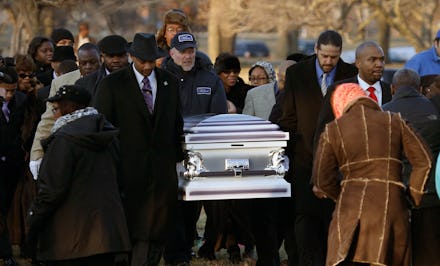The 918 Shootings in Chicago This Year Aren't Just About Gun Control

The news: Early Saturday morning, Chicago police found 18-year-old Brian Weekly unresponsive in the city's Washington Park neighborhood. They pronounced him dead at the scene, making him the third casualty on a weekend that claimed four lives and saw at least 30 people shot.
Image Credit: AP
By now, such news is commonplace. Hearing about another bloody weekend in Chicago has become such white noise in popular discussion that the national media barely covers it. But one pattern defining the city's violence remains impossible to ignore: Of the 3,484 people murdered since January 2007, upwards of 73% have been black.
This is not a new phenomenon: Even the most cursory glance at violence in the city reveals its concentration in neighborhoods like Roseland, Englewood and Austin, all of which are over 85% African-American. The 918 shootings that have taken place in 2014 sustain this pattern thus far.
Even more broadly, an Ebony article from March 2013 claims the six police districts with the highest murder rates from 2007 to 2011 had black populations over 94%. But there's another factor at play. While many have written about these racial disparities — whether in extensive statistical explorations or meditations on the resulting atmosphere of inequality and its discontents — most point to gang violence and gun availability as primary causes.
Yet recent events are bringing to light a more insidious culprit. It's notably less intuitive and harder to untangle, but has roots in a history that's just as vital and uniquely American. Steve Bogira outlines it in the Chicago Reader when he says that, more than just citing "gang-related" elements, we must attribute the city's violence to its root cause: housing segregation.
Why this is important: As the dust settled around the NBA's Donald Sterling debacle, critics rightly bemoaned the hypocrisy of banning the ex-Clippers owner for racist comments when a few years earlier, he'd been caught red-handed refusing to rent property to black and Latino tenants.
The reasons for this outrage stem from their fallout. As Ta-Nehisi Coates explains in his massive "The Case for Reparations," such discrimination lies at the center of everything from wealth disparities between blacks and whites to the concentration of poverty in black communities. In few places is this more pronounced than Chicago: Often cited as one of the most divided metros in America, this was where housing segregation met one of its "more practiced advocate[s]."
"[Chicago's] mayors and aldermen razed neighborhoods and segregated public housing," writes Coates. "Its businessmen lobbied for racial zoning. Its realtors block-busted whole neighborhoods, flipping them from black to white and then pocketing the profit."
Image Credit: Business Insider (Key: Red=white people; blue=black people; orange=Hispanic; green=Asian)
The results were definitive. Funneling black residents into strictly defined chunks of the city provided a perfect blueprint for imposed disadvantage.
"[Housing] determines access to transportation, green spaces, decent schools, decent food, decent jobs and decent services," Coates adds. It also "affects your chances of being robbed and shot as well as your chances of being stopped and frisked."
Concentrating blacks in specified areas, paired with their deliberate impoverishment, had lasting implications. Neighborhoods like North Lawndale, a focal point of Coates' piece, remain among the city's poorest and most violent. None of this would have been possible without Chicago's racist housing practices: "If you sought to advantage one group of Americans and disadvantage another," writes Coates, "you could scarcely choose a more graceful method than housing discrimination."
But: All of this is to say that violence in modern Chicago is neither sudden nor unexpected. It is the fruit of seeds sown years ago. Nowhere is this clearer than when looking at citywide murder rates, seeing them decline and realizing they remain highest, by a stunning margin, in neighborhoods long zoned for black residents.
It's a point that cannot be overstated. And for the sake of viable solutions, it outlines root causes that must be properly attributed in all related conversations moving forward.